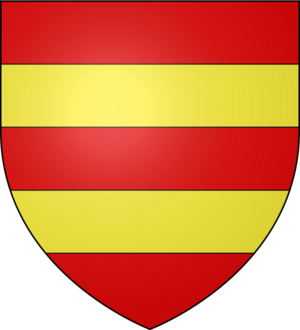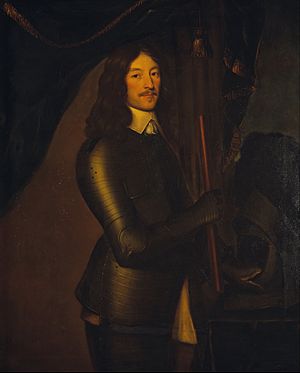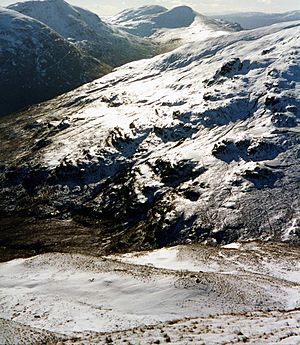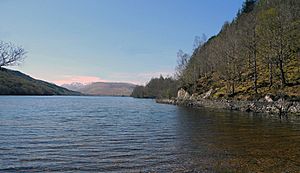Ewen Cameron of Lochiel facts for kids
Quick facts for kids
Sir Ewen Cameron of Lochiel
|
|
|---|---|

Sir Ewen Cameron, Laird of Lochiel
|
|
| Nickname(s) | Ulysses of the Highlands Eòghain Dubh ('Black Ewan') |
| Born | February 1629 Kilchurn Castle, Argyll, Scotland |
| Died | 12 June 1719 (aged 90) Achnacarry, Lochaber, Scotland |
| Buried | |
| Allegiance | |
| Years of service | 1645–1689 |
| Relations | John Cameron, Lord Lochiel (son) Donald Cameron of Lochiel (grandson) |
Sir Ewen Cameron of Lochiel (Scottish Gaelic: Eòghain Dubh Mac Dhòmhnaill Dubh; February 1629 – 12 June 1719) was a famous Scottish soldier and clan chief. He was the 17th leader of Clan Cameron, known as the Lochiel.
Sir Ewen was famous for his part in the Wars of the Three Kingdoms in Scotland (1645–1658). He also played a key role in the Jacobite rising of 1689. Many people see him as one of the strongest and bravest Highland chiefs ever.
The writer Lord Macaulay called Lochiel the "Ulysses of the Highlands". This means he was very clever and tricky. A story about his amazing strength inspired Sir Walter Scott's poem, Lady of the Lake.
Contents
Early Life of a Highland Chief
Ewen Cameron of Lochiel was born in February 1629. His birthplace was Kilchurn Castle, which belonged to his mother's family. His father, John Cameron, died when Ewen was young. His mother was Margaret Campbell.
Ewen's grandfather, Allan Cameron, was the 16th chief. After his father died, Ewen was looked after by family friends. Later, he spent much of his youth living with the Marquess of Argyll as a sort of guest or hostage.
While with Argyll, Ewen learned many things. He loved hunting, duelling, and fencing. He wasn't as keen on books, but he was very smart and strong-willed. In 1647, he became the chief of the Camerons. This made him the leader of one of the most important Highland clans.
How Lochiel Looked
Lord Lovat, who visited the French court, said Lochiel looked a lot like King Louis XIV. He said they looked "nearer than commonly that between two brothers". The only difference was that Sir Ewen was darker, stronger, and bigger.
Lord Macaulay called him the "Ulysses of the Highlands". This means he was seen as very clever and a great leader. James Philip of Almerieclos, a soldier, wrote a poem about Lochiel. He described Lochiel's scary look. He had a "Spanish countenance" with "flashing eyes" and a "moustache curled as the moon horns."
Fighting for the King
Early Battles and Loyalty
The Cameron clan always strongly supported the Royal Stuarts, the kings of Scotland. In 1645, Ewen saw the Battle of Inverlochy. His grandfather sent 300 Highland warriors to help the King's side. Ewen himself had to be with the other side, led by Argyll.
That same year, he also saw the Battle of Philiphaugh, where the King's army lost badly. It's said that Ewen became a strong supporter of the King after meeting Sir Robert Spottiswood. Sir Robert was about to be executed by the Covenanters, who were against the King. Ewen was also greatly inspired by James Graham, Marquis of Montrose, a famous Royalist leader.
When his grandfather died in 1647, Ewen finally left Argyll. He went back to his home in Lochaber. His clan welcomed him with great joy. Some other clan leaders, like Macdonald of Keppoch, thought they could trick the new young chief. They refused to pay their yearly respect to Lochiel. Ewen quickly gathered hundreds of his men. He marched them to force the Macdonalds to obey him.
In 1650, Montrose was defeated and executed. Later that year, King Charles, who was in exile, asked Lochiel for help. The King wanted him to gather his men and join the Royalist army. This army was defeated at Inverkeithing in 1651.
The Glencairn Rebellion
In August 1653, Lochiel joined other Scottish nobles at Lochearn. They decided to fight against the government and bring King Charles back. Lochiel joined the army of William Cunningham, 9th Earl of Glencairn. He brought several hundred Cameron warriors with him.
At the Battle of Tullich on February 10, 1654, Lochiel was second-in-command. He led his Highlanders to defend a narrow mountain pass. They fought against a much larger force led by Robert Lilburne. Lochiel's men caused heavy losses, and Lilburne's forces had to retreat. King Charles personally praised Lochiel for his actions at Tullich. He called him the "deliverer of the Highland army."
Continued Resistance
Lochiel kept fighting with Glencairn until 1654. Then, John Middleton took over command. During this time, George Monck became Governor of Scotland. Monck kept the rebels trapped in the Highlands.
Lochiel continued to fight for four more years using guerrilla warfare. This means he used small, surprise attacks. He became a symbol of resistance for the King's supporters in the Highlands. In 1655, Lochiel built a new home at Achnacarry Castle. This was to keep his men further away from the government troops.
He only stopped fighting when Oliver Cromwell died in 1658. Lochiel then gave up to General Monck. Monck respected Lochiel's brave actions during the war. Soon after, Lochiel went with Monck to London. There, they discussed bringing the King back. After much talk, it was decided that King Charles would return from exile. The Royal House of Stuart would be back on the throne.
The King Returns
In 1660, King Charles II returned to the throne. He welcomed Lochiel warmly for his loyal service during the war. Lochiel then went back to his lands in Lochaber. This began a short time of peace.
Clan Conflicts
The Clan Cameron and Clan Mackintosh had been fighting for 360 years. This long feud was over land near Loch Arkaig, Lochaber. On September 20, 1665, Lochiel ended this famous feud. This happened after a stand-off at the Fords of Arkaig, near Achnacarry. After this, Lochiel worked to keep peace between his clan and their former enemies.
However, in 1668, while Lochiel was in London, another fight broke out. This was between Clan Donald and some parts of Clan Mackintosh. Lochiel’s clansmen helped the MacDonalds win the Battle of Maol Ruadh (Mulroy). This is often called the last clan battle.
One famous story says that in 1680, Lochiel killed the last wolf in Scotland.
Gaelic poets often told stories of Lochiel's brave deeds. They did this at his new home, Achnacarry. One poet called Achnacarry "the generous house of feasting." It was a "pillared hall of princes, where wine goes round freely in gleaming glasses."
At the Royal Court
In the late 1660s, Lochiel spent time at King Charles's court. He was well-received there. During this time, he became friends with James, Duke of York. James later became King James VII and II.
In 1681, the Duke of York made Lochiel a knight. This meant he was given the title "Sir." A story says that the Duke tried to pull Lochiel's sword from its sheath but couldn't. He said Lochiel's sword was "uneasy to draw when the crown wanted his services." Lochiel then easily pulled out his sword and offered it to the Duke. The Duke then knighted him.
The Jacobite Uprising
The Glorious Revolution in 1688 was a bad time for Lochiel. King James VII and II was overthrown by William of Orange. Lochiel was very loyal to the Stuart kings. He became one of the main commanders in the Jacobite rising of 1689. He managed to bring together many Highland clans who were loyal to the Stuart cause.
Lochiel led these Highlanders alongside John Graham of Claverhouse, also known as "Bonnie Dundee." They fought at the Battle of Killiecrankie. This was a great victory, but Claverhouse died. Sadly, the Jacobite rebellion soon fell apart. This was because the remaining leaders argued and were not good at leading.
By this time, Sir Ewen was almost sixty years old. He began to give his son, John Cameron, more responsibility. John led the clan for the rest of the 1689 rebellion. He also led them in the later 1715 and 1719 uprisings. In 1717, Prince James, the exiled Stuart king, made John Cameron "Lord Lochiel." This was to thank him for his loyalty.
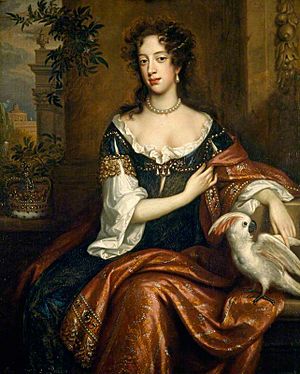
Family Life
Sir Ewen married three times and had sixteen children. His first wife was the daughter of Macdonald of Sleat. She was said to be very beautiful but died in 1657 without having children. His second wife was Isobel Maclean. She also died. His last wife was Jean Barclay.
Children with Isobel Maclean:
- John Cameron, 1st Lord Lochiel (1663–1747): He became the chief after his father. He was the father of Donald Cameron of Lochiel, known as the Gentle Lochiel. Donald played a big part in the 1745 Jacobite rising.
- Major Donald Cameron of Clunes (died 1719): He was an officer in the Dutch army. He fought against his own father at Killiecrankie.
- Allan Cameron (died 1730): He was a Jacobite agent and worked at court. He married Isobel Fraser and died in Rome.
- Margaret Cameron: She married Alexander MacGregor Drummond of Balhaldie.
- Anne Cameron: She married Allan Maclean.
- Catherine Cameron: She married William MacDonald of Boronaskittoch.
- Janet Cameron: She married John Grant of Glenmoriston.
Children with Jean Barclay:
- James Cameron: He died young.
- Ludovic Cameron of Torcastle (died 1753): He was a Jacobite officer. He fought alongside his nephew in the 1745 rising.
- Christian Cameron: She married Allan Cameron of Glendessary. She was the mother of the famous Jean Cameron of Glendessary.
- Jean Cameron: She married Lachlan MacPherson, Chief of Clan MacPherson. She was the mother of Cluny MacPherson.
- Isobel Cameron: She married Archibald Cameron of Dungallon.
- Lucia Cameron: She married Patrick Campbell of Barcaldine.
- Ket Cameron: She married John Campbell of Achalader.
- Una Cameron: She married her cousin Robert Barclay of Ury.
- Marjory Cameron: She married Allan MacDonald of Morar.
Death of a Legend
Sir Ewen Cameron died peacefully in 1719 when he was ninety years old. He was buried with a grand ceremony. His burial place was an old graveyard on the shores of Loch Eil. It is said that thousands of Gaels (Scottish Highlanders) and thirteen pipers came to his funeral.
Lochiel in Stories
- The Lady of the Lake: In this poem by Sir Walter Scott, a fight scene is based on a legendary battle involving Lochiel.
- Tales of a Grandfather: Also by Sir Walter Scott, this book talks about Lochiel. It mentions how he lived to be very old and became like a child again. This shows a contrast to his strong warrior youth.
- The Grameid: This long poem in Latin is about the 1689 campaign. It features Lochiel and was written by James Philip of Almerieclos.
- The Jacobite Trilogy: These are historical novels by D. K. Broster. They focus on the Cameron clan's role in the 1745 uprising.


